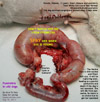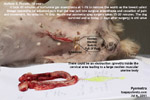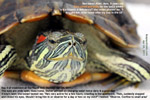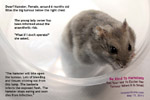CASE 1. This 11-year-old poodle survived the surgery and anaesthesia performed by Vet 1, despite a serious heart disease. But she died two days after the surgery, presumed to be due to heart failure.
I first saw this poodle, female, unspayed, 9 years in 17 March 2009 for an "asthmatic" attack. She had heart murmurs and was given oral lasix. The owner reported that the dog no longer suffered from "asthma".
As she had bad breath, I advised dental work which was scheduled. No teeth was extracted as they were in good condition. Only dental scaling was done under isoflurane and oxygen gas anaesthesia. The dog was all right.
July 20, 2009, Vet 1 prescribed some medication for a "swollen face" and a review in 10 days' time.
Aug 5, 2009, I extracted the left upper PM4 tooth as it was an oro-nasal fistula which presented as a "swollen face" to Vet 1. Vet 1 had prescribed medication and advised review. Two years went by with no visits from the poodle owner. Then on
July 8, 2011 - Vet 2 was consulted and recorded a grade 5/5 heart murmur. The blood test showed a normal total white cell count. However the Monocytes were high suggestive of a chronic infection. Some information of the blood test is as follows:
Total White Cell Count was normal. Monocytes 14% (1.4 x 10(9)/L). Neutrophils 60%. Lymphocytes 22%, Eosinophils 3.8%, Basophils 1.04%. Urea was high but creatinine levels were low.
| July 21, 2011 - Ultrasound showed swollen left and right uterine horns. A diagnosis of open pyometra was made. The dog was operated the next day and the swollen womb was taken out. She survived the surgery but died 2 days later. |
 This
is a typical case in which the dog would have lived longer
if she had been spayed when she was one year old. In
addition, she had bad teeth which seeded bacteria damaging
the heart valves over her last few years of life. 11 years
of life is considered a long life in Singapore's small
breeds. However, this poodle could have lived a pain-free
life if she had been spayed at one year of age and would not
have suffered from pus and bacteria during old age.
This
is a typical case in which the dog would have lived longer
if she had been spayed when she was one year old. In
addition, she had bad teeth which seeded bacteria damaging
the heart valves over her last few years of life. 11 years
of life is considered a long life in Singapore's small
breeds. However, this poodle could have lived a pain-free
life if she had been spayed at one year of age and would not
have suffered from pus and bacteria during old age.
CASE 2.
In another case, the owner of a 13-year-old dog could not
decide whether to get her operated as she was discharging
pus from her vagina for the past weeks and was no longer
eating. He consulted Vet 1 who diagnosed pyometra.
However, he asked me to operate despite being given a very poor prognosis of survival on the operating table. But he wanted the dog home on the same day after operation to care for her. The dog surprisingly survived the surgery and anaesthesia for around 10 days with him treating her at home. On Day 3 after surgery, the dog had fits and came down for IV drip. She passed away at home around Day 7. This second case showed that it was very difficult for the owner to request euthanasia and the option of surgery, as in the first case, was too late as the dog was very ill by then. So, the survival rate was very low. However, it is not always death for old dogs with pyometra. The chances of survival post-operation are very slim as the old dog could be suffering from kidney failure due to bacterial infections over the last few years. One of the signs of kidney infections or failure would be vomiting in the dogs with pyometra.
I have stopped advocating spays in young female dogs as many Singapore owners feel that it is cruel to deprive a female dog of her reproductive organs or have some other reasons. Reproductive disorders come in when the female dog is old, leading to much pain from infections, sadness for the owner and higher veterinary expenses of pyometra surgery.
 TOA
PAYOH VETS
TOA
PAYOH VETS



